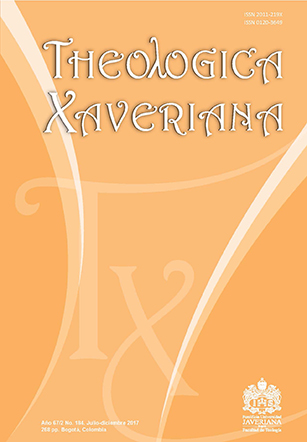Abstract
Este artículo continúa la indagación sobre el ejercicio de inculturación de la teología en el quehacer teológico de Gregorio de Nisa en su obra De vita Moysis. Se busca mostrar la forma como este autor dialogó con la cultura de su época y su aporte en el esfuerzo por hacer inteligible la fe cristiana. Como son muchos los elementos culturales implicados en su obra, se ofrece como ejemplo la referencia al mito de la caverna.
Balderas Vega, Gonzalo. Jesús, cristianismo y cultura en la Antigüedad y en la Edad Media. México: Universidad Iberoamericana, 2007.
Basilio di Cesarea. “Come leggere i classici. Consigli ai giovani”. Martino Sanna, http://www.martinosanna.de/materiali/Basilio_di_Cesarea.pdf (consultado el 27 de marzo de 2016).
Castellanos de Losada, Basilio Sebastián. Biografía eclesiástica completa. Vol. 23. Madrid: Imprenta de Alejandro Gómez Fuentenebro, 1868.
Daniélou, Jean. “Grégoire de Nysse et la philosophie”. En Gregor von Nyssa und die Philosophie. Zweites Internationales Kolloquium über Gregor von Nyssa, Freckenhorst bei Münster 18-23 September 1972, editado por Herausgegeben von Heinrich Dörrie, Margarete Altenburger y Uta Schramm, 3-18. Leiden: E. J. Brill, 1976.
_____. L´essere e il tempo in Gregorio di Nissa. Roma: Arkeios, 2000.
_____. Le IV siecle: Gregoire de Nysse et son milieu. Paris: Institut Catholique, 1974.
_____. “Orientations actuelles de la recherche sur Grégoire de Nysse”. En Écriture et culture philosophique dans la pensée de Grégoire de Nysse, Actes du Colloque de Chevetogne (22-26 september 1969), editado por Marguerite Harl, 3-17. Leiden: E. J. Brill, 1971.
_____. Platonisme et théologie mystique: essai sur la doctrine spirituelle de Saint Grégoire de Nysse. Paris: Aubier, 1944.
Divenosa, Marisa y Claudia Mársico. Platón. La República. Buenos Aires: Losada, 2005.
Ferrer, Elisa. “Preposiciones y esquemas simbólicos en De vita Moysis de Gregorio de Nisa”. Revista de estudios clásicos 33 (2006): 33-51.
Fortier, Phillippe y Henri de Lubac. Origène. Homélies sur l’Exode. Paris: Du Cerf, 1947.
Gonzalez, Severino. “La fórmula Mia ousia treis ηψποστασει ζ en San Gregorio de Nisa”. Analecta Gregoriana Vol. XXI (1939) 1-146.
Grégoire le Thaumaturge. Remerciement a Origène suivi de la lettre d`Origène a Grégoire. Paris: Du Cerf, 1969.
Harl, Marguerite. Origène et la fonction révélatrice du Verbe Incarné. Paris: Du Seuil, 1958.
Jaeger, Werner y Elsa Cecilia Frost. Cristianismo primitivo y paideia griega. Breviarios Vol. 182. México: Fondo de Cultura Económica, 1974.
Marcus, Ralph. Philo. Questions and Answers on Exodus. Cambridge (MA): Harvard University Press, 1953.
Mateo-Seco, Lucas Francisco. (ed.). Gregorio de Nisa. Sobre “La vida de Moisés”. Biblioteca de Patrística 23. Madrid: Ciudad Nueva, 1993.
Mateo-Seco, Lucas Francisco. y Giulio Maspero (eds.). Diccionario sobre Gregorio de Nisa. Burgos: Monte Carmelo, 2006.
Méhat, André. Origène. Homèlies sur les Nombres. París: Du Cerf, 1951.
Mondin, Battista. Storia della metafisica. Vol. 1. Bolonga: Edizioni Studio Domenicano: 1998.
Quasten, Johannes. Patrología. I. Hasta el Concilio de Nicea. Madrid: Biblioteca de Autores Cristianos, 1968.
_____. Patrología. II. La edad de oro de la literatura patrística griega. Madrid: Biblioteca de Autores Cristianos, 1985.
Reale, Giovanni y Dario Antiseri. Historia del pensamiento filosófico. 3 vols. Barcelona: Herder, 2010.
Reale, Giovanni y Enrico Peroli. Platonismo e cristianesimo. ¿Antagonismo o comuni fondamenti? Milano: Vita e Pensiero, 1993.
Ropero, Antonio. Lo mejor de los padres apostólicos. Barcelona: Clie, 2004.
Rovira Belloso, José María. Introducción a la teología. Madrid: Biblioteca de Autores Cristianos, 1996.
Solano Pinzón, Orlando. “Aporte del De vita Moysis de Gregorio de Nisa a la
inculturación de la teología hoy”. Franciscanum 163, Vol. LVII (2015): 325-360.
_____. “Inculturación de la teología en Gregorio Nisa: antecedentes.” Theologica Xaveriana 179 (2015): 157-183. Disponible en: http://dx.doi.org/10.11144/javeriana.tx65-179.itgn (consultado el 27 de marzo de 2016).
_____. “La paideia como estructura fundamental del quehacer teológico en Gregorio de Nisa”. Veritas 32 (2015): 229-244.
Torres Moreno, Eduardo. San Gregorio de Nisa: “De Vita Moysis”: estudio estructural. Madrid: Universidad Complutense, 2005.
Trevijano Etchevarria, Ramón. Patrología. Madrid: Biblioteca de Autores Cristianos, 1994.
Von Balthasar, Hans Urs. Présence et pensée. Essai sur la philosophie religeuse de Grégoire de Nysse. Paris: Beauchesne, 1942.
Woìniakp, Robert. “El valor teológico-epistemológico del deseo humano de Dios en De vita Moysis de San Gregorio de Nisa”. Scripta Theologica 38/2 (2006): 473-499.
Zamperini, Luciano. Platone. Un maestro del pensiero occidentale. Firenze: Gruppo Editoriale, 2003.
Esta revista científica se encuentra registrada bajo la licencia Creative Commons Reconocimiento 4.0 Internacional. Por lo tanto, esta obra se puede reproducir, distribuir y comunicar públicamente en formato digital, siempre que se reconozca el nombre de los autores y a la Pontificia Universidad Javeriana. Se permite citar, adaptar, transformar, autoarchivar, republicar y crear a partir del material, para cualquier finalidad (incluso comercial), siempre que se reconozca adecuadamente la autoría, se proporcione un enlace a la obra original y se indique si se han realizado cambios. La Pontificia Universidad Javeriana no retiene los derechos sobre las obras publicadas y los contenidos son responsabilidad exclusiva de los autores, quienes conservan sus derechos morales, intelectuales, de privacidad y publicidad.
El aval sobre la intervención de la obra (revisión, corrección de estilo, traducción, diagramación) y su posterior divulgación se otorga mediante una licencia de uso y no a través de una cesión de derechos, lo que representa que la revista y la Pontificia Universidad Javeriana se eximen de cualquier responsabilidad que se pueda derivar de una mala práctica ética por parte de los autores. En consecuencia de la protección brindada por la licencia de uso, la revista no se encuentra en la obligación de publicar retractaciones o modificar la información ya publicada, a no ser que la errata surja del proceso de gestión editorial. La publicación de contenidos en esta revista no representa regalías para los contribuyentes.



